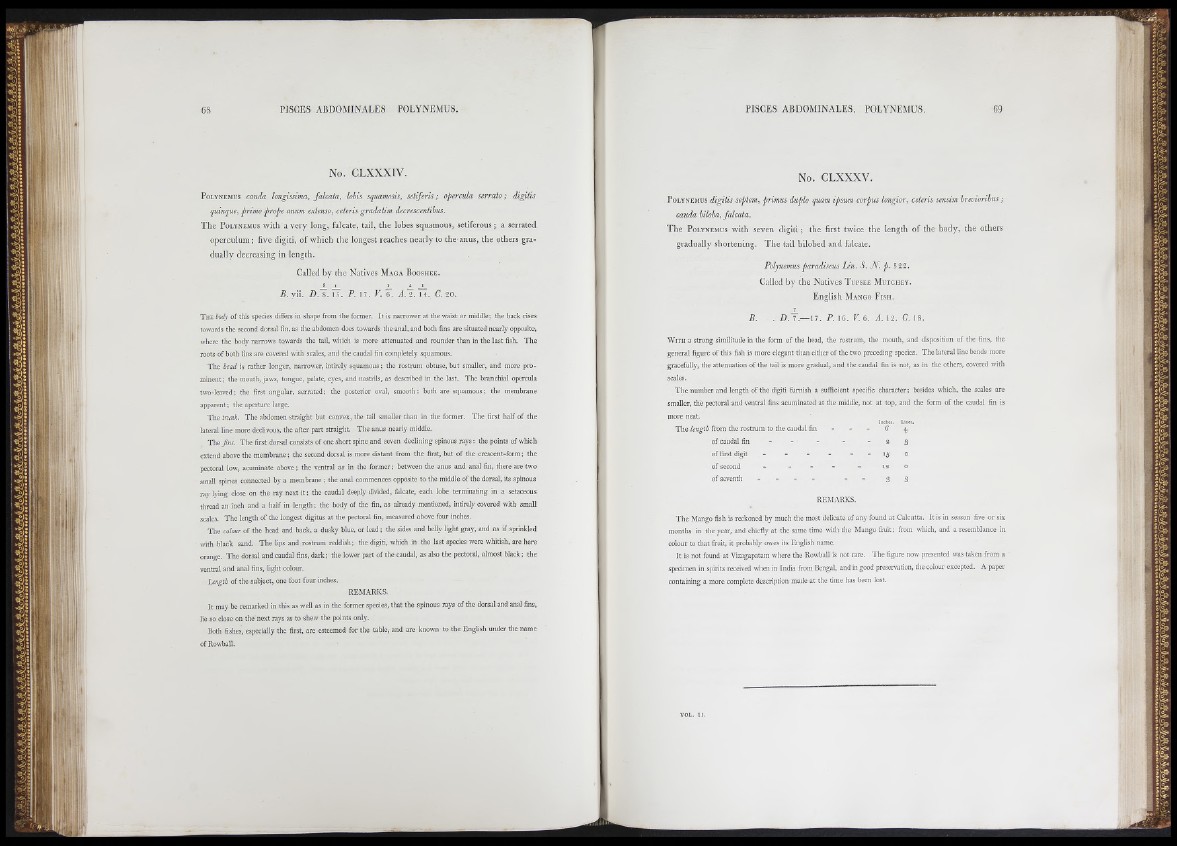
ill IMi
lU
i l "
H
(
jii
I
i* •
II
I It
No. CLXXXIV.
PoLYNEMUS cauda longissima, Jalcala, lobis squamosis, seiiferis; opercida serrato; digitis
quinque, primo prope anum extenso, ceteris gradatim decrescentibus.
T h e PoLYNEMus w i th a v e r y lo n g , fa lc a te , ta il, th e lob es squ am ou s , s e t i fe ro u s ; a serrated
o p e r c u lum ; fiv e d ig it i , o f w h i c h the lon g e s t r e a ch e s n e a r ly to the an u s , th e o ther s grad
u a l ly d e c r e a s in g in len g th .
Called b y the Natives M.^v g a B o o s h e e .
D. 8. 15. P. 17. V. 6. A. 2. 14. C. 20.
Th e body of this species differs in shape from the former. It is narrower at the waist or middle; the back rises
towards the second dorsal fin, as the abdomen does towards the anal, and both fins are situated nearly opposite,
where tlie body narrows towards the tail, wliich is more attenuated and rounder than in tlie last fish. The
roots of both fins are covered with scales, and the caudal fin completely squamous.
The head is rather longer, narrower, intirely squamous; the rostrum obtuse, but smaller, and more prominent;
the mouth, jaws, tongue, palate, eyes, and nostrils, as described in the last. The branchial opercula
two-leaved; the first angular, serrated; the posterior oval, smooth: both are squamous; the membrane
apparent; the aperture large.
The trunk. The abdomen straight but convex, the tail smaller than in the former. The first half of the
lateral line more declivous, the after part straight. The anus nearly middle.
The Jns. The first dorsal consists of one short spine,and seven declining spinous rays: the points of which
extend above the membrane; the second dorsal is more distant from the first, but of the crescent-form; the
pectoral low, acuminate above; the ventral as in the former; between the anus and anal fin, there are two
small spines connected by a membrane ; the anal commences opposite to the middle of the dorsal, its spinous
ray lying close on the ray next it; the caudal deeply divided, falcate, each lobe terminating in a setaceous
thread an inch and a half in length; the body of the fin, as already mentioned, intirely covered with small
scales. The length of the longest digitus at the pectoral fin, measured above four inches.
T he colour of the head and back, a dusky blue, or lead ; the sides and belly light gray, and as if sprinkled
with black sand. The lips and rostrum reddish; the digiti, which in the last spedes were whitish, are here
orange. The dorsal and caudal fins, dark; the lower part of the caudal, as also the pectoral, almost black; the
ventral and anal fins, light colour.
Lengtb of the subject, one foot four inches.
REMARKS.
It may be remarked in this as well as in the former species, that the spinous rays of the dorsal and anal fins,
lie so close on the next rays as to shew the points only.
Both fishes, especially the first, are esteemed for the table, and are known to the English under the name
of Rowball.
■LI: A
No. CLXXXV.
PoLYNEMUs digitis scptcm, primus duplo quam ipsum corpus longior, ceteris sensim breuioribus ;
cauda biloba, Jalcala.
T h e PoLYNEMUs with .seven d ig id ; the first twice the length o f the body, the others
gradually shortening. T h e tail bilobed and falcate.
Polynemus paradiseus Lin. S. X . p . 5 22.
C a l l e d b y the Natives T u p s e e M u t c h e y .
English M a n g o F i s h .
B . . D .~ .— n . P. 16. V. 6. A. 1 2 . c . \ S .
W ith a strong similitude in the form o f the head, the rostrum, the mouth, and disposition o f the fins, the
general figure o f this fish is more elegant than either of the tw o preceding species. T h e lateral line bends more
g racefully, the attenuation o f the tail is more g radual, and the caudal fin is not, as in the others, covered with
scales.
The number and length of the digiti furnish a sufficient specific character; besides which, the scales are
smaller, the pectoral and ventral fins acuminated at the middle, not at top, and the form of the caudal fin is
more neat.
The length from the rostrum to the caudal fin - - -
Lincs.
4;
o f caudal fin - - - - - a 3
of first digit - - - - - - 1 5 0
o f second - - - i s o
o f seventh - - - - - 3 3
REMARKS.
The Mango fish is reckoned by much the most delicate of any found at Calcutta. It is in season five or six
months in the year, and chiefly at the same time with tlie Mango fruit; from which, and a resemblance in
colour to that fruit, it probably owes its English name.
It is not found at Vizagapatam wliere the Rowball is not rare. The figure now presented was taken from a
specimen in spirits received when in India from Bengal, and in good preservation, the colour excepted. A paper
containing a more complete description made at the time has been lost.